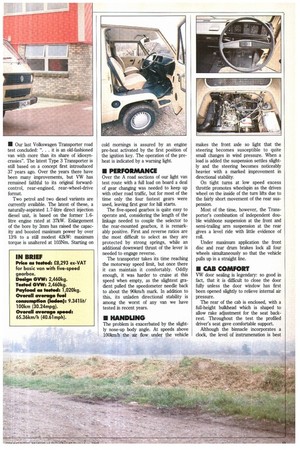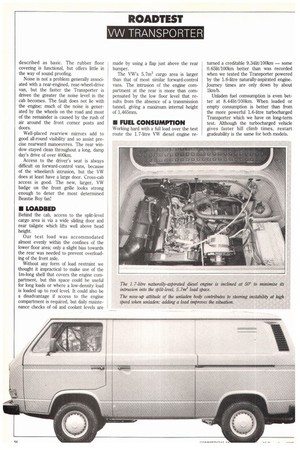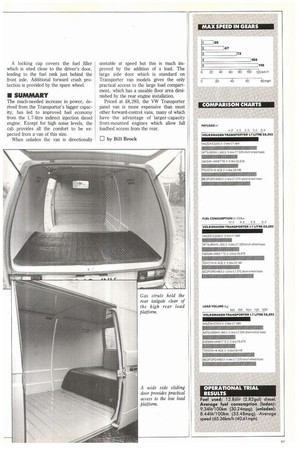ASIER ON THE JUICE
Page 56

Page 57

Page 58

Page 59

If you've noticed an error in this article please click here to report it so we can fix it.
• Our last Volkswagen Transporter road test concluded: ". . . it is an old-fashioned van with more than its share of idiosyncrasies". The latest Type 3 Transporter is still based on a concept first introuduced 37 years ago. Over the years there have been many improvements, but VW has remained faithful to its original forwardcontrol, rear-engined, rear-wheel-drive format.
Two petrol and two diesel variants are currently available. The latest of these, a naturally-aspirated 1.7-litre direct injection diesel unit, is based on the former 1.6litre engine rated at 371M. Enlargement of the bore by 3mm has raised the capacity and boosted maximum power by over 13% to a still modest 42kW: maximum torque is unaltered at 103Nm. Starting on cold mornings is assured by an engine pre-heat activated by the first position of the ignition key. The operation of the preheat is indicated by a warning light.
• PERFORMANCE
Over the A road sections of our light van test route with a full load on board a deal of gear changing was needed to keep up with other road traffic, but for most of the time only the four fastest gears were used, leaving first gear for hill starts.
The five-speed gearbox is quite easy to operate and, considering the length of the linkage needed to couple the selector to the rear-mounted gearbox, it is remarkably positive. First and reverse ratios are the most difficult to select as they are protected by strong springs, while an additional downward thrust of the lever is needed to engage reverse.
The transporter takes its time reaching the motorway speed limit, but once there it can maintain it comfortably. Oddly enough, it was harder to cruise at this speed when empty, as the slightest gradient pulled the speedometer needle back to about the 90Icm/h mark. In addition to this, its unladen directional stability is among the worst of any van we have tested in recent years.
• FUMBLING
The problem is exacerbated by the slightly nose-up body angle. At speeds above 100km/h the air flow under the vehicle makes the front axle so light that the steering becomes susceptible to quite small changes in wind pressure. When a load is added the suspension settles slightly and the steering becomes noticeably heavier with a marked improvement in directional stability.
On tight turns at low speed excess throttle promotes wheelspin as the driven wheel on the inside of the turn lifts due to the fairly short movement of the rear suspension.
Most of the time, however, the Transporter's combination of independent double wishbone suspension at the front and semi-trailing arm suspension at the rear gives a level ride with little evidence of roll.
Under maximum application the front disc and rear drum brakes lock all four wheels simultaneously so that the vehicle pulls up in a straight line.
• CAB COMFORT
VW door sealing is legendary: so good in fact, that it is difficult to close the door fully unless the door window has first been opened slightly to relieve internal air pressure.
The rear of the cab is enclosed, with a full-height bulkhead which is shaped to allow rake adjustment for the seat backrest. Throughout the test the profiled driver's seat gave comfortable support.
Although the binnacle incorporates a clock, the level of instrumenation is best described as basic. The rubber floor covering is functional, but offers little in the way of sound proofing.
Noise is not a problem generally associated with a rear-engined, rear-wheel-drive van, but the faster the Transporter is driven the greater the noise level in the cab becomes. The fault does not lie with the engine; much of the noise is generated by the wheels on the road and most of the remainder is caused by the rush of air around the front corner posts and doors.
Well-placed rearview mirrors add to good all-round visibility and so assist precise rearward manoeuvres. The rear window stayed clean throughout a long, damp day's drive of over 400km.
Access to the driver's seat is always difficult on forward-control vans, because of the wheelarch intrusion, but the VW does at least have a large door. Cross-cab access is good. The new, larger, VW badge on the front grille looks strong enough to deter the most determined Beastie Boy fan!
• LOADBED
Behind the cab, access to the split-level cargo area is via a wide sliding door and rear tailgate which lifts well above head height.
Our test load was accommodated almost evenly within the confines of the lower floor area; only a slight bias towards the rear was needed to prevent overloading of the front axle.
Without any form of load restraint we thought it impractical to make use of the lm-long shelf that covers the engine compartment, but this space could be useful for long loads or where a low-density load is loaded up to roof level. It could also be a disadvantage if access to the engine compartment is required, but daily maintenance checks of oil and coolant levels are made by using a flap just above the rear bumper.
The VVV's 5.7m3 cargo area is larger than that of most similar forward-control vans. The intrusion of the engine compartment at the rear is more than compensated by the low floor level that results from the absence of a transmission tunnel, giving a maximum internal height of 1,465nun.
• FUEL CONSUMPTION
Working hard with a full load over the test route the 1.7-litre VW diesel engine re turned a creditable 9.341it/100km — some 0.651it/100km better than was recorded when we tested the Transporter powered by the 1.6-litre naturally-aspirated engine. Journey times are only down by about Unladen fuel comsumption is even better at 8.441it/100km. When loaded or empty consumption is better than from the more powerful 1.6-litre turbocharged Transporter which we have on long-term test. Although the turbocharged vehicle gives faster hill climb times, restart gradeability is the same for both models. A locking cap covers the fuel filler which is sited close to the driver's door, leading to the fuel tank just behind the front axle. Additional forward crash protection is provided by the spare wheel.
• SUMMARY
The much-needed increase in power, derived from the Transporter's bigger capacity, has led to improved fuel economy from the 1,7-litre indirect injection diesel engine. Except for high noise levels, the cab provides all the comfort to be expected from a van of this size.
When unladen the van is directionally unstable at speed but this is much improved by the addition of a load. The large side door which is standard on Transporter van models gives the only practical access to the large load compartment, which has a useable floor area diminished by the rear engine installation.
Priced at £8,293, the VW Transporter panel van is more expensive than most other forward-control vans, many of which have the advantage of larger-capacity front-mounted engines which allow full loadbed access from the rear.
CI by Bill Brock
































































































